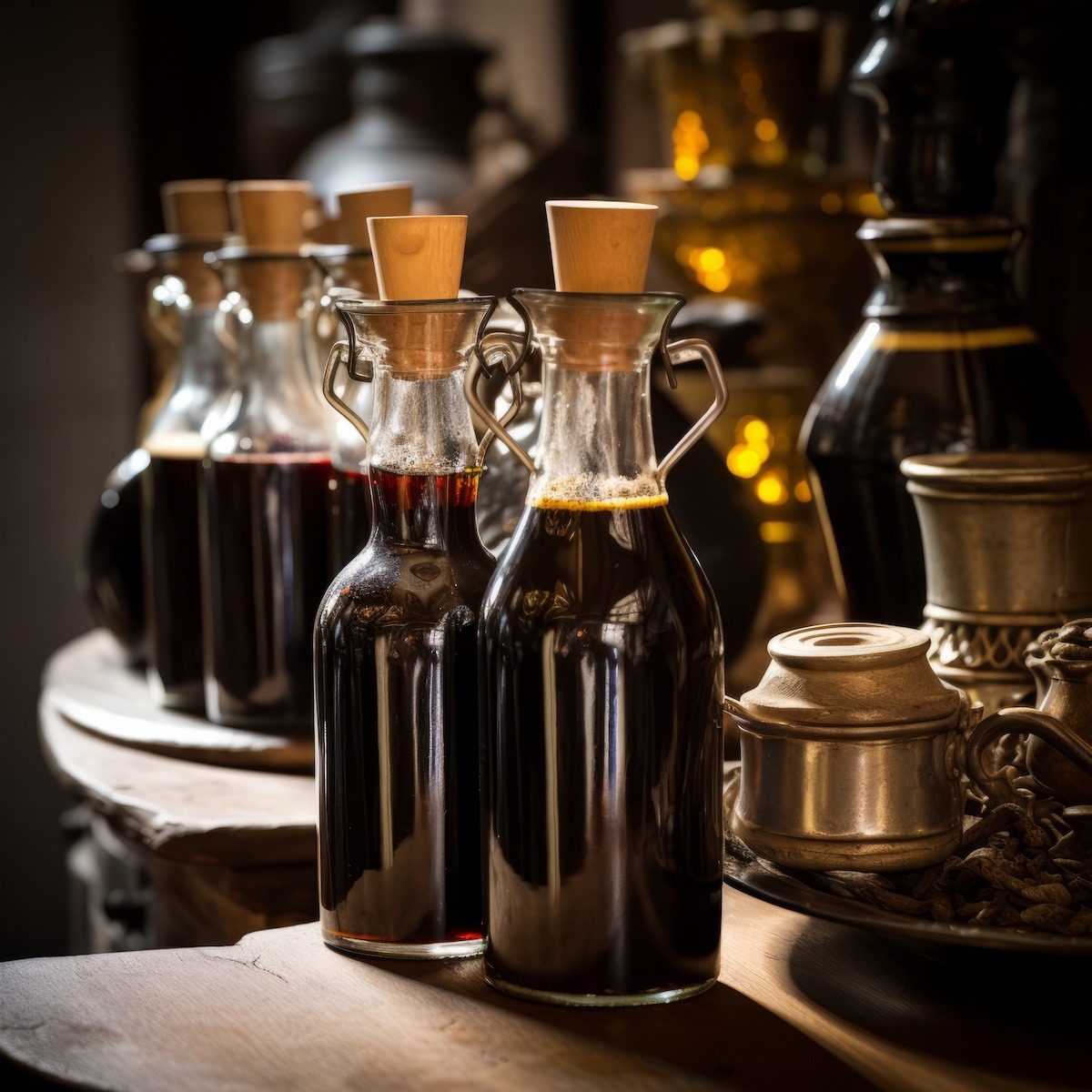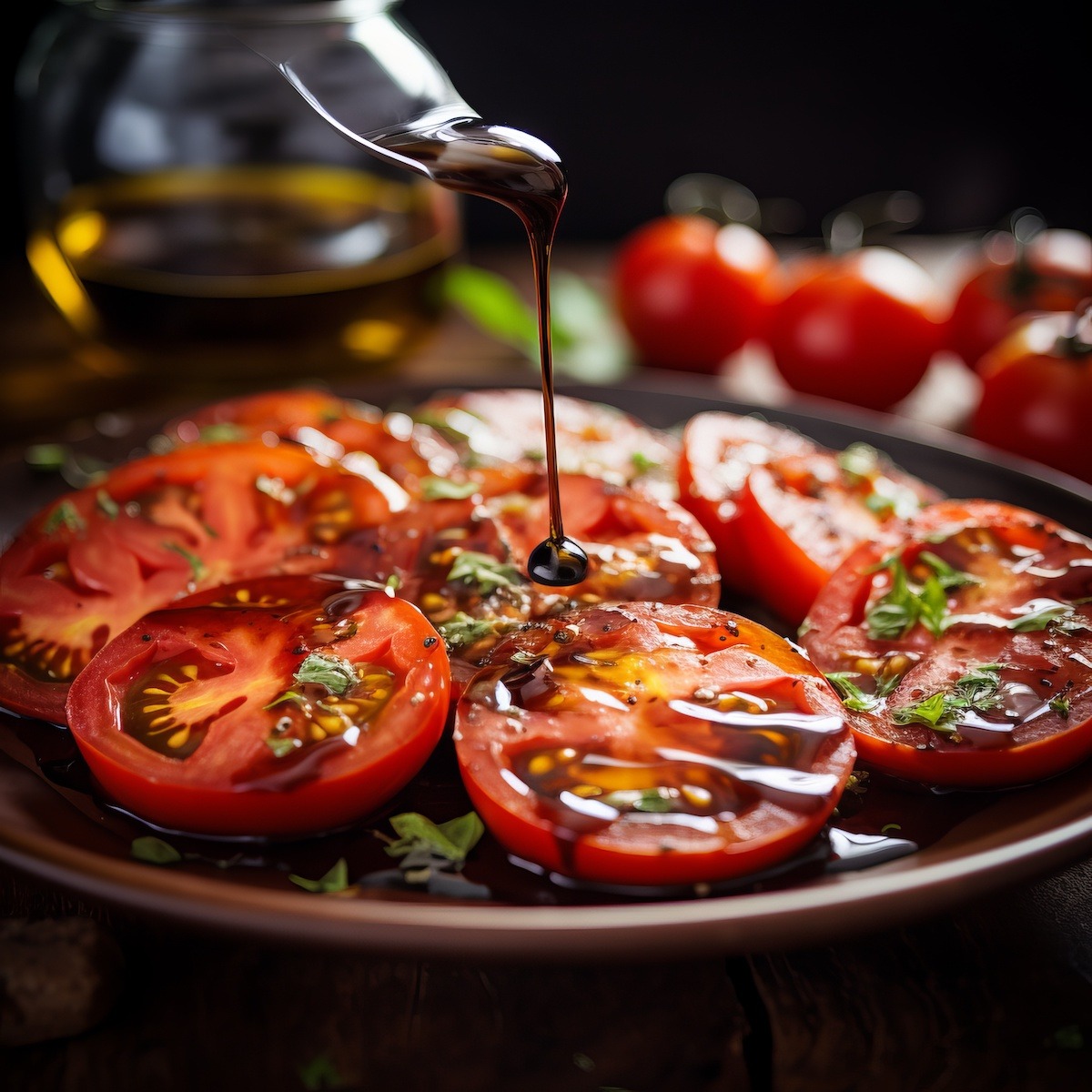


Everything You Need To Know About Balsamic Vinegar
We enjoy balsamic vinegar year-round as a complement to tomato, mozzarella, and basil to, topping grilled chicken breasts to add another layer of flavor. I have purchased the really expensive aged balsamic, the cheap stuff you can find in most supermarkets and many in between.
This post will describe this remarkable vinegar, give you its history, and explain the differences between extremely expensive and less expensive brands. I hope you enjoy what you learn.
What is balsamic vinegar?
Balsamic vinegar is a type of vinegar made from pressed grapes, typically Trebbiano and Lambrusco varieties. It is aged in wooden barrels for several years to develop its signature sweet, sour, and complex flavor profile. Balsamic vinegar is commonly used in salad dressings, marinades, and reductions.
How is it made?
Balsamic vinegar is made from a reduction of pressed grapes, usually Trebbiano or Lambrusco varieties. The grapes are cooked down to a concentrated syrup and then fermented and aged for several years in a series of wooden barrels.
The traditional production method involves aging the vinegar in barrels made of different types of wood, such as chestnut, oak, mulberry, and cherry, which impart unique flavors to the vinegar. The aging process also helps to concentrate the flavors and produce the characteristic sweet, sour, and complex taste of balsamic vinegar.
The final product is bottled and sold as balsamic vinegar. However, some mass-produced varieties of balsamic vinegar are made quickly, often with the addition of wine vinegar or caramel, and may not undergo the traditional aging process.
What is its history?
Balsamic vinegar has a long history dating back to Italy’s Middle Ages. It was initially produced by noble families in Modena and Reggio Emilia to preserve the excess grape harvest from their vineyards.
Over time, balsamic vinegar became a prized condiment and symbol of wealth, with some families keeping their balsamic vinegar recipes and production methods a closely guarded secret. Today, balsamic vinegar is widely produced and enjoyed globally, with both traditional and mass-produced varieties available on the market.
How is it different from red wine vinegar?
Balsamic vinegar and red wine vinegar are both types of vinegar made from fermented liquids, but there are some differences between them.
- Origin: Balsamic vinegar is made from pressed grapes, typically Trebbiano or Lambrusco varieties, while red wine vinegar is made from red wine.
- Flavor: Balsamic vinegar has a sweet, complex flavor profile that results from the aging process in wooden barrels, while red wine vinegar is more straightforward, with a strong, acidic taste.
- Texture: Balsamic vinegar is thicker and more syrupy than red wine vinegar.
- Uses: Balsamic vinegar is typically used as a condiment or to enhance the flavor of dishes, while red wine vinegar is more commonly used in salad dressings, marinades, and sauces.
- Production method: Traditional balsamic vinegar undergoes a multi-step aging process in wooden barrels, while red wine vinegar is produced by fermenting red wine to produce vinegar.
Aging and what it does to the flavor?
Balsamic vinegar is aged to develop its complex, sweet, and sour flavor profile. The aging process also helps to concentrate the flavors and produce the characteristic consistency of balsamic vinegar.
Wood imparts unique flavors to the vinegar during the aging process, which evolves and develops over time. The longer the vinegar is aged, the thicker and sweeter it becomes. This is because some liquid evaporates, leaving a more concentrated syrup-like substance behind.
In addition to the influence of the different types of wood, aging also allows for the growth of acetobacter, a type of bacteria that converts alcohol into acetic acid. This contributes to the tangy and sour notes in the vinegar. The aging process is integral to balsamic vinegar production, contributing to its distinct flavor, aroma, and consistency.


What is added to balsamic vinegar to make it less expensive?
Mass-produced and commercial balsamic vinegar is often made to be less expensive than traditional balsamic vinegar. To achieve this, they may use lower-quality grapes or add other ingredients to the vinegar, such as wine vinegar, caramel, or sugar.
Some mass-produced and commercial balsamic vinegar may also contain thickening agents, such as corn starch or glucose syrup, to create the syrupy consistency characteristic of balsamic vinegar. Additionally, they may contain artificial flavors, colors, or preservatives to enhance the flavor and extend the product’s shelf life.
What are its health benefits?
Balsamic vinegar has been touted for its potential health benefits, which include the following:
- Antioxidant properties: it contains antioxidants such as polyphenols, which can help protect the body against oxidative stress and cellular damage.
- Supporting healthy digestion: it has been shown to increase the production of digestive enzymes, which can help improve the digestion of food and reduce symptoms of digestive issues such as heartburn and bloating.
- Lowers blood sugar levels: Some studies suggest that consuming balsamic vinegar with a meal can help lower blood sugar levels and improve insulin sensitivity in people with type 2 diabetes.
- Supports heart health: it contains compounds that have been shown to have anti-inflammatory and anti-atherosclerotic effects, which can help to support heart health.
- Helps with weight management: Some research suggests that consuming balsamic vinegar as part of a low-calorie diet may help with weight loss by increasing feelings of fullness and reducing consumed food.
It is important to note that more research is needed to fully understand balsamic vinegar’s health benefits and determine its optimal consumption dose. Additionally, not all balsamic vinegar is created equal, and some cheaper versions may contain added sugars or other ingredients that may offset its potential health benefits.
How do you know if my balsamic vinegar is authentic?
To determine if your balsamic vinegar is authentic, you can look for specific characteristics and certifications that indicate traditional production methods and high quality.
- Label: Traditional it is often labeled as “Aceto Balsamico Tradizionale di Modena” or “Aceto Balsamico Tradizionale di Reggio Emilia,” indicates that it was produced in either Modena or Reggio Emilia, Italy, following strict production regulations. The label should also state that the balsamic vinegar has been aged for a minimum of 12 years.
- Appearance: it should be thick, syrupy, rich, and dark.
- Flavor: it should have a complex and well-balanced flavor with sweet and sour notes.
- Price: it can be expensive due to the long aging process and the use of high-quality ingredients. If the price seems too good to be true, it may indicate that the vinegar is not authentic.
- Certification: it may carry the “DOP” (Denominazione di Origine Protetta) or “IGP” (Indicazione Geografica Protetta) seals, which indicate that the product has been certified as meeting strict production standards and comes from a specific geographic region.
Ways to use balsamic vinegar.
Balsamic vinegar is a versatile ingredient used in various dishes to add depth and complexity to flavors. Some ways to use it in cooking include:
- Salad dressing: it can be mixed with olive oil, salt, and pepper to make a simple and flavorful salad dressing.
- Glaze: it can be simmered with sugar and other seasonings to make a sweet, savory glaze for meats, fruits, and vegetables.
- Marinade: it can be mixed with herbs, spices, and oils to create a marinade for meats and vegetables.
- Sauce: Balsamic vinegar can be reduced with wine, stock, or fruit juice to make a flavorful sauce for meats, fish, and vegetables.
- Reduction: it can be reduced to a syrupy consistency and used as a drizzle for dishes, such as meats, cheese, or fruits.
- Grilled vegetables: it can be brushed onto vegetables before grilling to add depth and complexity to their flavors.
- Desserts: Balsamic vinegar can be used in desserts, such as sorbets, ice creams, or fruit salads, to add a sweet and tangy flavor.
Are all balsamic vinegar created equally?
No, not all balsamic vinegar is created equally. There are significant differences in quality, flavor, and authenticity among various balsamic vinegars available on the market.
- Traditional balsamic vinegar: Produced in Modena and Reggio Emilia, Italy, following strict production regulations and using the traditional aging method in a series of wooden barrels. This type of balsamic vinegar is highly prized for its complex and rich flavor and is often sold in small bottles at a premium price.
- Mass-produced balsamic vinegar: Made with a quicker production method and often with the addition of wine vinegar or caramel, this type of balsamic vinegar may undergo a different process than traditional aging and is typically sold at a lower price.
- Commercial balsamic vinegar: Made with cheaper ingredients and not necessarily following any strict production regulations, this type of balsamic vinegar may contain added thickeners and artificial flavors and is often sold at a lower price point.


Varieties
There are several different varieties of balsamic vinegar, each with its own unique flavor profile and production method:
- Traditional Balsamic Vinegar (Aceto Balsamico Tradizionale): Aged for a minimum of 12 years, this high-quality balsamic vinegar is made in Modena and Reggio Emilia, Italy, following strict production regulations. It is known for its complex, rich flavor and dark color.
- Condimento Balsamico: Aged for a minimum of 3 years, this balsamic vinegar is made similarly to traditional balsamic vinegar but may contain added wine vinegar. It is a more affordable alternative to traditional balsamic vinegar and is used as a condiment.
- Aged Balsamic Vinegar: Made from wine vinegar aged in wood barrels to give it a more complex flavor and consistency. This type of balsamic vinegar is often less expensive than traditional balsamic vinegar.
- White Balsamic Vinegar: Made from white grapes, this balsamic vinegar has a lighter color and a milder, sweeter flavor compared to traditional balsamic vinegar.
- Flavored Balsamic Vinegar: Made by adding natural or artificial flavors to balsamic vinegar, such as fruit, spices, or herbs. This type of balsamic vinegar adds flavor to dishes or as a condiment.
What does it taste like?
Balsamic vinegar has a unique and complex flavor that is sweet and sour. The flavor of balsamic vinegar can vary depending on its age, the grapes used to produce it, and the production methods used.
Traditional balsamic vinegar, aged for a minimum of 12 years, has a rich, complex flavor that is well-balanced with sweet and sour notes. The aging process in wood barrels gives the vinegar a smooth and syrupy consistency with a deep, dark color.
Younger balsamic vinegar, such as condimento balsamico, has a milder flavor and a lighter color compared to traditional balsamic vinegar. They may also have a sharper and more acidic taste, as they have not been aged for as long as traditional balsamic vinegar.
White balsamic vinegar has a milder, sweeter flavor compared to traditional balsamic vinegar. It is made from white grapes, which gives it a lighter color and a milder taste.
What does balsamic vinegar cost?
The cost of balsamic vinegar can vary widely depending on several factors, including its age, quality, and place of origin.
Traditional balsamic vinegar, aged for a minimum of 12 years, can be expensive, costing upwards of $50 or more per bottle. However, this type of balsamic vinegar is considered high quality and is made from premium ingredients using traditional methods.
Younger balsamic vinegar, such as condimento balsamico, is less expensive and can cost anywhere from $10 to $30 per bottle. This vinegar is not aged for as long as traditional balsamic vinegar and may have a milder flavor and a lighter color.
Lower-quality balsamic vinegar may be made from cheaper ingredients and may contain added sugars or other artificial flavorings. These kinds of vinegar can cost anywhere from a few dollars to $10 per bottle.
What is the oldest balsamic vinegar available to buy?
The oldest balsamic vinegar available for purchase is typically considered traditional balsamic vinegar, aged for a minimum of 12 years. However, some traditional balsamic vinegars are aged even longer, up to 25 years or more. I have tasted them, and they are amazing but not worth the cost.
It is worth noting that older balsamic vinegar is also available for purchase, but these are typically reserved for special occasions or as gifts. These older balsamic vinegar are rare and expensive and may cost several hundred dollars per bottle.
Where do the best balsamic vinegars come from?
The best balsamic vinegar is typically considered to come from the Modena region of Italy. This is because this region has a long history of producing traditional balsamic vinegar and is the birthplace of the “Traditional Balsamic Vinegar of Modena” (TBV) denomination of protected origin.
Traditional Balsamic Vinegar of Modena is made using a specific process that involves cooking down a blend of Trebbiano and Lambrusco grapes to create a thick syrup called “grape must.” This grape must is then aged in a series of wooden barrels for a minimum of 12 years, with the oldest vinegar aged up to 25 years or more.
The aging process, the type of wood used for the barrels, and the blend of grapes must all contribute to the final product’s unique flavor profile and quality. As a result, the TBV is a highly prized and sought-after product, considered one of the finest examples of Italian cuisine.
That said, balsamic vinegar from other regions of Italy and other countries can also be high-quality and delicious. Some other well-known balsamic vinegar producers include the Emilia-Romagna region of Italy, Spain, and the United States. When purchasing balsamic vinegar, looking for products labeled as “Traditional Balsamic Vinegar of Modena” or that carry other certifications or designations of quality is essential.
Substitutes
If you don’t have balsamic vinegar on hand or are looking for a substitute, here are a few options you can use:
- Red wine vinegar is a good substitute for balsamic vinegar, especially if you use it in a recipe that requires a tangy and acidic flavor.
- Apple cider vinegar: This vinegar has a milder flavor than balsamic vinegar but can still be used as a substitute in a pinch.
- Sherry vinegar: Sherry vinegar has a nutty flavor that can complement the flavors in many dishes.
- Rice vinegar: Rice vinegar is mild and sweet, making it a good substitute for balsamic vinegar in lighter dishes.
- White wine vinegar: White wine vinegar is a mild, light-colored vinegar that can be used as a substitute for balsamic vinegar in recipes where the flavor of the vinegar is not the main focus.
Remember that these substitutes will have a different depth of flavor and sweetness than traditional balsamic vinegar. However, they can still add tanginess and acidity to your recipes.
📖 Recipe
Balsamic Vinegar Glaze
A balsamic vinegar glaze is a sweet and tangy sauce that can add flavor to meats, fruits, and vegetables.
Ingredients
- 1 cup balsamic vinegar
- 2 tablespoons sugar
- 1 tablespoon honey
- ½ teaspoon salt
- ¼ teaspoon black pepper
Instructions
Combine the balsamic vinegar, sugar, honey, salt, and pepper in a medium saucepan.
Place the saucepan over medium heat and bring the mixture to a boil.
Reduce the heat to low and allow the mixture to simmer for 10-15 minutes or until it has thickened to a syrup-like consistency.
Remove the saucepan from heat and allow the glaze to cool to room temperature.
Use the glaze as a drizzle for meats, fruits, or vegetables, or store it in an airtight container in the refrigerator for later use.
Notes
The cooking time may vary depending on the desired consistency of the glaze. If you prefer a thicker glaze, simmer the mixture for a more extended period. If you prefer a thinner glaze, remove it from heat sooner.
Some of My Favorite Sauce Recipes
 Print
Print





